Holding Together

Much of our basic technology has to do with attaching things. Of course, in the new world of computers, documents can be made to stay together by a very simple command, like “Attach.” But in the world behind those electronic frontiers, the world of actual Things, it was – and still is – not quite so simple.
The first things people wanted to “join” in some way were probably pieces of wood and rock, to create primitive weapons or tools. Assisting in the “binding” process, there were, at first, various kinds of string, cord, or rope, made from vegetable fibers, or from animal parts. Then along came metals, and the development of fasteners which we call nails. For many centuries, these had to be made individually. Today, of course, they are mass-produced, and, instead of being hammered in, they can be “shot” into the wood by machines.
But, while we live in a world in which paper can be very important, we have need for methods of holding sheets of it together. There is the ubiquitous paper-clip – which has various drawbacks, including the possibility of wrong things getting accidentally clipped together. They also tend to accumulate in collections of unused paper clips, since millions more are being manufactured every year, and, apart from being tossed in the trash, there is no easy way to dispose of them.
But the happy alternative is what we call a metal staple, which is much smaller than a paper clip, and fastens much more securely. These are now in their third century – but what we call a modern “stapler” came into existence almost within living memory. It was a company called Swingline which introduced a device that could hold a whole row of staples and apply them one at a time exactly where needed.
Modern Medicine has of course devised its own means of stapling human flesh, as in the process of closing wounds and helping them to heal.
There are many other ways of connecting things. Some creatures seem to have it all figured out. How does a fly walk upside down on the ceiling? It all has to do with what we call adhesives, and their powers of stickiness. For us, there are various kinds of pastes and glues. In some ways, these are less important than they used to be. In the era of the Wright brothers and subsequent early flying machines, that method of holding parts together was preferable to nuts and bolts because weight was a crucial factor. No doubt it still is in the production of spacecraft.
The early kinds of adhesive tape were a big medical advance because they stuck to skin and were very helpful in holding bandages in place. But they were unsightly and didn’t stretch – and you know how much better off your wounds are today.
Then came Scotch Tape, invented by somebody at the 3M Company. It was transparent, like cellophane, but much stronger, and you could tear off just how much you wanted from a suitable dispenser. And it was surprisingly cheap – which was actually how it got its name, from the stereotypical image of a Scot as a tightwad.
Some modern glues are so powerfully sticky that, at least according to their spectacular commercials, a small amount can hold the weight of a full-grown person – though I for one can’t readily think of any likely situation in which I would be dangling so precariously – certainly not voluntarily.
But in nature it is not only flies on the ceiling which have their own ways of adhering to things. It was in fact one of these techniques which inspired one of the most successful modern methods of holding things together – and in the process, giving a new word to many languages : VELCRO, which was invented in Switzerland.
This brings to mind a movie called The Third Man, in which Harry Lime, an underworld figure, compares two cultures:
“In Italy for 30 years under the Borgias they had warfare, terror, murder, and bloodshed, but they produced Michelangelo, Leonardo da Vinci, and the Renaissance. In Switzerland they had brotherly love – they had 500 years of democracy and peace, and what did that produce? The cuckoo clock.”
According to all the songs and many of the stories, there is no more powerful, and more durable, attachment than LOVE; and I might add, to a writer of epigrams, no more useful – as in:
“Aren’t we lucky! Eternity has hardly begun,
and already we have found each other.”






